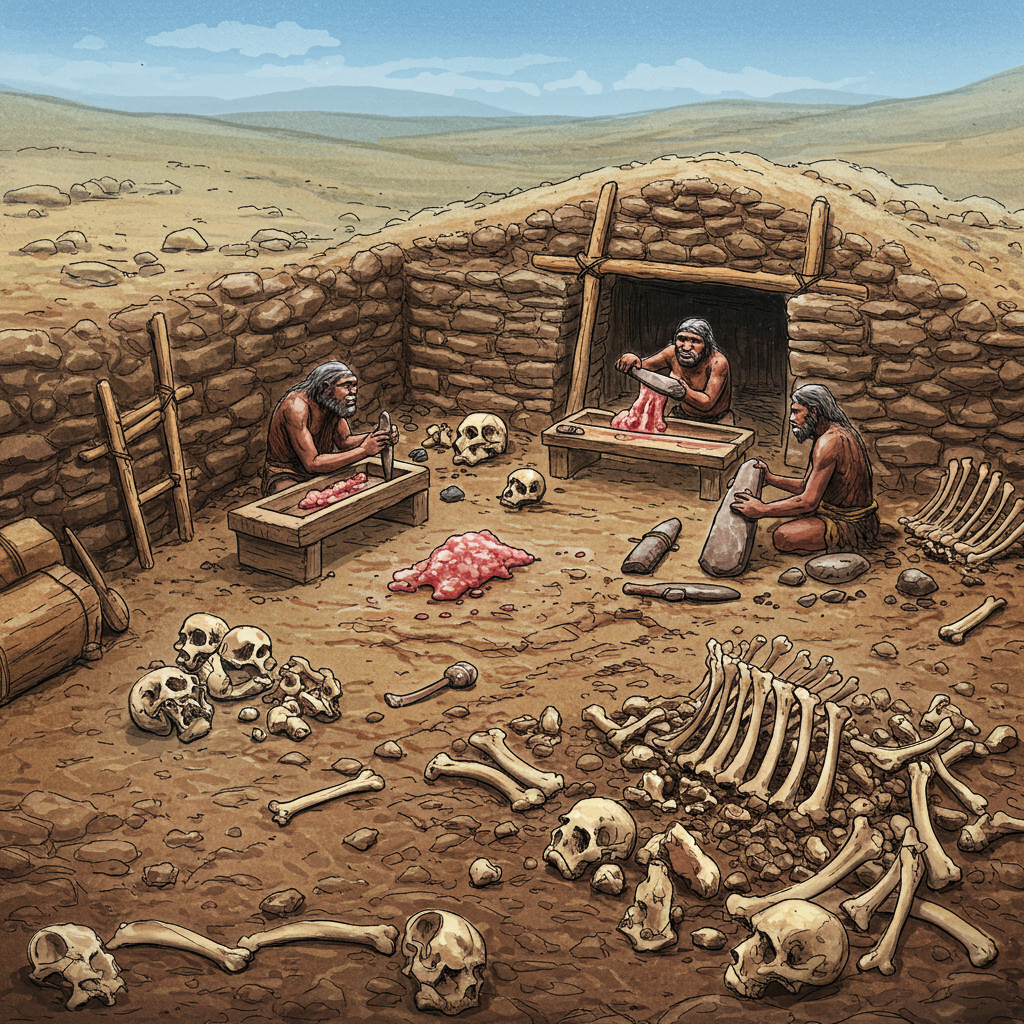A groundbreaking archaeological discovery is reshaping our understanding of neanderthals, our closest extinct human relatives. Located in what is now eastern Germany, a 125,000-year-old site offers compelling evidence of sophisticated, large-scale resource management. Researchers have unearthed what they describe as a Neanderthal “fat factory.” This ancient facility was dedicated to processing animal bones to extract highly valuable bone marrow and grease.
This remarkable finding pushes back the timeline for complex nutritional strategies among hominins by tens of thousands of years. It confirms that Neanderthals were engaging in intensive bone processing, including rendering fat, long before modern humans in Europe are known to have practiced this technique. The revelation paints a picture of Neanderthals as strategic planners with a deep understanding of nutrition and resource efficiency.
Unearthing an Ancient Processing Hub
The site, known as Neumark-Nord, lies in a former lake landscape near the city of Halle in eastern Germany. Excavations here have yielded an astonishing collection of more than 100,000 bone fragments. These fragments come from at least 172 large mammals, including species like horses and deer. The sheer volume of remains indicates a significant level of activity.
Analysis of the bones revealed far more than just leftover scraps from hunting. A substantial number showed clear cut marks. Many also bore signs of intentional breakage and crushing. This evidence strongly suggests deliberate butchering and processing. Tools, such as flint artifacts and hammer stones, were also found concentrated in the same relatively small area, alongside indications of fires. This combination points clearly to an organized, systematic bone processing operation.
The Purpose: Fueling the Ancient Diet
Why would ancient humans invest so much effort in processing bones? The answer lies in nutrition. Bone marrow is rich in calories and essential fatty acids. Bone grease, extracted from spongy bone tissue, is an even more concentrated source of fat. For hunter-gatherers, especially during periods when other food sources were scarce, accessing these hidden fats was crucial for survival.
Scientists propose a multi-step process likely employed by the Neanderthals at Neumark-Nord. First, they would smash the large bones to access the marrow inside. Then, they would further break and crush the bones into smaller fragments. Evidence suggests these fragments were then boiled in water. This boiling process causes the fat to separate from the bone and float to the surface. From there, it could be skimmed off and consumed. Bones found at the site were frequently broken in areas known to be particularly fat-rich, supporting this interpretation.
A Strategy Against Starvation
Fat played a critical role in the Neanderthal diet. Like other ancient hunter-gatherers, their food intake was heavily reliant on animal protein. While protein is essential, consuming too much lean meat without sufficient fat or carbohydrates can lead to a dangerous condition. This is often called “rabbit starvation” or protein poisoning. It occurs when the body struggles to metabolize excessive protein, leading to nutrient imbalances that can be fatal.
A diet lacking sufficient fat provides insufficient energy, particularly vital during cold periods or when facing the demands of a nomadic lifestyle. Extracting calorie-dense fat from bones provided a vital supplement. This could help Neanderthals avoid protein poisoning and maintain energy levels. This practice wasn’t just about getting extra calories; it was a sophisticated nutritional strategy for survival in their environment.
Evidence of Advanced Planning and Resource Management
The scale and organization of the Neumark-Nord site challenge traditional portrayals of Neanderthals as less capable than modern humans. Archaeologist Lutz Kindler, lead author of the study, describes the activity as “intensive, organized, and strategic.” He emphasizes that the Neanderthals were “clearly managing resources with precision.” This involved careful planning, not just spontaneous action.
Their activities included planning hunts for large mammals, transporting specific parts of carcasses to the processing site, and rendering fat in a dedicated area. This implies an understanding of the landscape and how to best utilize its resources over time. Sabine Gaudzinski-Windheuser, another archaeologist involved, notes that bone grease production requires a significant volume of bones to make the labor worthwhile. The massive collection at Neumark-Nord indicates an operation conducted on a substantial scale, suggesting a coordinated effort.
This level of planning goes beyond simply reacting to immediate needs. It suggests foresight and potentially even some form of food storage. Rendered fat could be preserved for later use, a practice associated with more complex foraging societies. The Neumark-Nord discovery pushes back the known timeline for such resource intensification significantly. Previous strong evidence for this kind of labor-intensive processing only dated back around 28,000 years ago, much later than the 125,000-year-old Neumark-Nord findings.
Redefining Neanderthal Capabilities
The “fat factory” discovery adds to a growing body of evidence showcasing Neanderthal sophistication. Recent research has demonstrated their ability to produce complex adhesives like birch bark pitch. This required intricate temperature control. Other studies suggest they were adept swimmers and capable of abstract thought. There’s also evidence they engaged in nurturing child-rearing and used speech patterns similar to humans. Some findings even hint at symbolic behavior, like possibly burying their dead with flowers or diving for seashells for tools.
The Neumark-Nord site, with its exceptional preservation, provides a unique window into an entire ancient ecosystem. Computer scientist Fulco Scherjon notes that the site’s size and preservation allow researchers to study how Neanderthals impacted their environment, both animal and plant life. This capability to analyze different activities within a preserved landscape, as highlighted by archaeologist Wil Roebroeks, reveals a species capable of diverse behaviors, from hunting strategies to specialized processing sites.
While Homo sapiens ultimately thrived and Neanderthals became extinct, sites like Neumark-Nord reveal that the difference was not necessarily one of simple intelligence versus advanced capability. Neanderthals were complex beings with advanced cognitive abilities, strategic planning skills, and sophisticated knowledge of their environment and how to extract maximum value from its resources.
Frequently Asked Questions
What was the Neanderthal ‘fat factory’?
The Neanderthal ‘fat factory’ refers to an archaeological site at Neumark-Nord in eastern Germany, dating back 125,000 years. It was a dedicated area where Neanderthals systematically processed the bones of large mammals like horses and deer. Their goal was to extract highly nutritious bone marrow and bone grease. This involved smashing and crushing bones, likely followed by boiling them to render the fat.
Why is this Neanderthal fat factory discovery important?
This discovery is significant because it provides the earliest clear evidence of sophisticated, large-scale bone processing for fat extraction by hominins. It shows Neanderthals were using this technique around 100,000 years before modern humans in Europe are known to have done so. This challenges previous views of Neanderthals and highlights their advanced planning, resource management, nutritional understanding, and technological capabilities, adding to evidence of their intelligence.
How did Neanderthals extract fat from bones?
Evidence from the Neumark-Nord site suggests a multi-step process. Neanderthals first used tools to smash bones to reach the marrow. They then broke the bones into smaller fragments. These fragments were likely boiled in water. This boiling allowed the bone grease to separate and rise to the surface, where it could be collected. This labor-intensive method demonstrates their knowledge of animal anatomy and resourceful ancient technology.
Conclusion
The discovery at Neumark-Nord provides compelling evidence that Neanderthals were far more sophisticated than often depicted. Their ability to establish a dedicated “fat factory” for systematic bone processing reveals advanced planning, a deep understanding of nutrition, and efficient resource management. This complex behavior, dating back 125,000 years, underscores their intelligence and adaptability. Archaeological sites like this continue to unveil the complex lives and capabilities of our ancient relatives, challenging old stereotypes and offering new insights into human evolution. As researchers continue to explore sites with exceptional preservation like Neumark-Nord, we can anticipate even more revelations about the ingenuity of Neanderthals.




